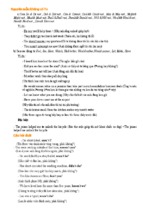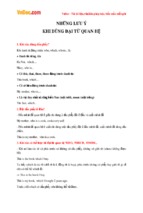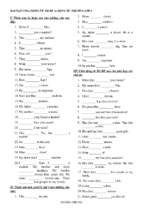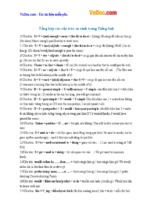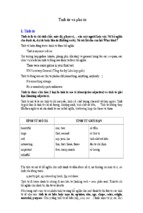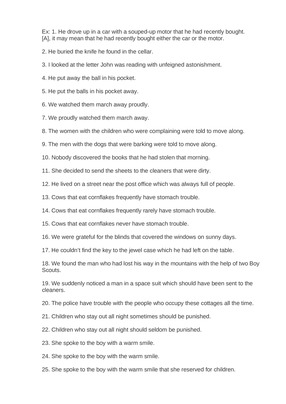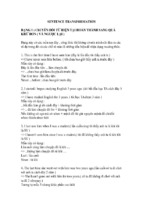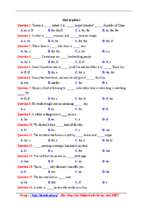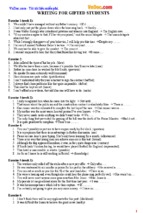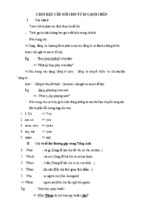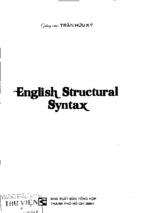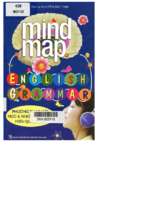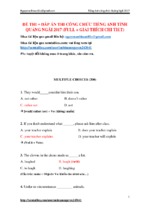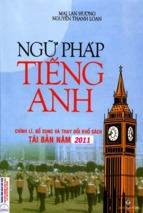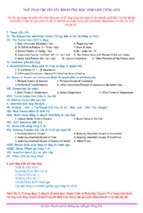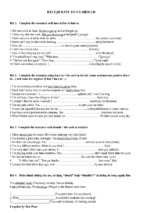See discussions, stats, and author profiles for this publication at: https://www.researchgate.net/publication/270568943
Syntax Workbook
Book · January 2011
CITATIONS
READS
0
5,169
1 author:
Mick Perkins
The University of Sheffield
89 PUBLICATIONS 1,299 CITATIONS
SEE PROFILE
All content following this page was uploaded by Mick Perkins on 07 January 2015.
The user has requested enhancement of the downloaded file.
SYNTAX
WORKBOOK
Mick Perkins
NP
m :NP
m :A dj P h:n
h:n
q:PP
h:pr e p
h:a dj
q:NP
m :A dj P
h:n
h:a dj
f i r st
l evel
c our s e i n s y nt a c t i c a na l y s i s
1
Syntax Workbook
Mick Perkins
Emeritus Professor of Clinical Linguistics
Department of Human Communication Sciences
University of Sheffield
© 2011
by the author
2
CONTENTS
7
INTRODUCTION
1
SENTENCE AND CLAUSE TYPES
10
2
CLAUSE ELEMENTS
11
2.1
V(VERB)
11
2.2
S (SUBJECT)
11
2.3
O (OBJECT)
12
2.4
Od (DIRECT OBJECT) & Oi (INDIRECT OBJECT)
13
2.5
C (COMPLEMENT)
14
2.6
Co (OBJECT COMPLEMENT)
15
2.7
A (ADVERBIAL)
15
2.8
Voc (VOCATIVE)
16
3
WH- QUESTIONS
18
4
PHRASES
20
5
6
7
4.1
PHRASAL EXPANSION OF CLAUSE ELEMENTS
20
4.2
THE STRUCTURE OF PHRASES
21
22
VERB PHRASES
5.1
STRUCTURE OF VERB PHRASES
22
5.2
MAIN VERB: v
22
5.3
AUXILIARY VERB: aux
23
5.4
MODAL IDIOMS: aux
23
5.5
VERB PARTICLE: part
23
5.6
NEGATOR: neg
24
5.6
REVIEW
24
26
NOUN PHRASES
6.1
STRUCTURE OF NOUN PHRASES
26
6.2
HEADS (h)
26
6.3
MODIFIERS (m)
27
6.4
DETERMINERS (d)
27
6.5
INITIATORS (i)
28
6.6
QUALIFIERS (q)
28
31
ADJECTIVE AND ADVERB PHRASES
7.1
STRUCTURE OF ADJECTIVE PHRASES
31
7.2
ADJECTIVE PHRASES AS CLAUSE ELEMENTS
32
7.3
ADJECTIVE PHRASES AS MODIFIERS IN NOUN PHRASES
32
3
7.4
STRUCTURE OF ADVERB PHRASES
32
7.5
ADVERB PHRASES AS CLAUSE ELEMENTS
33
7.6
ADVERB PHRASES AS MODIFIERS IN ADJECTIVE PHRASES
33
8
35
PREPOSITIONAL PHRASES
8.1
THE STRUCTURE OF PREPOSITIONAL PHRASES
35
8.2
PREPOSITIONAL PHRASES AS CLAUSE ELEMENTS
35
8.3
PREPOSITIONAL PHRASES AS QUALIFIERS IN NOUN PHRASES
36
8.4
PREPOSITIONAL PHRASES AS QUALIFIERS IN ADJECTIVE PHRASES
37
8.5
MULTIPLE EMBEDDED PREPOSITIONAL PHRASES
37
8.6
HEAD OF A PREPOSITIONAL PHRASE OR A VERB PARTICLE?
38
9
42
COORDINATION
9.1
COORDINATION OF CLAUSES
42
9.2
COORDINATION OF PHRASES
42
9.3
COORDINATION OF WORDS
43
10
46
COMPLEX SENTENCES
10.1
OVERVIEW
46
10.2
TESTS FOR IDENTIFYING SUBORDINATE CLAUSES
47
11
SUBORDINATE CLAUSES AS CLAUSE ELEMENTS
49
11.1
SUBJECT
49
11.2
DIRECT OBJECT
49
11.3
INDIRECT OBJECT
50
11.4
SUBJECT COMPLEMENT
50
11.5
OBJECT COMPLEMENT
50
11.6
ADVERBIAL
51
12
SUBORDINATE CLAUSES AS QUALIFIERS IN PHRASES
52
12.1
SUBORDINATE CLAUSES AS QUALIFIERS IN NOUN PHRASES
52
12.2
SUBORDINATE CLAUSES AS QUALIFIERS IN PREPOSITIONAL PHRASES
54
12.3
SUBORDINATE CLAUSES AS QUALIFIERS IN ADJECTIVE PHRASES
54
13
REVIEW EXERCISE
56
14
SUPPLEMENTARY SECTION
57
CHAPTER 1 SUPPLEMENT
57
CHAPTER 2 SUPPLEMENT
57
CHAPTER 3 SUPPLEMENT
58
CHAPTER 5 SUPPLEMENT
59
CHAPTER 6 SUPPLEMENT
60
CHAPTER 7 SUPPLEMENT
60
4
CHAPTER 8 SUPPLEMENT
61
CHAPTER 9 SUPPLEMENT
62
CHAPTER 10 SUPPLEMENT
63
CHAPTER 11 SUPPLEMENT
64
CHAPTER 12 SUPPLEMENT
65
ADVANCED REVIEW EXERCISE
69
15
71
KEY TO EXERCISES
EXERCISE 1.2
71
EXERCISE 2.1
71
EXERCISE 2.2
72
EXERCISE 2.3
72
EXERCISE 2.4
73
EXERCISE 2.5a
73
EXERCISE 2.5b
74
EXERCISE 2.6
74
EXERCISE 2.8
75
EXERCISE 2.9
75
EXERCISE 3.1
76
EXERCISE 3.2
77
EXERCISE 5.1
77
EXERCISE 5.2
78
EXERCISE 6.1
79
EXERCISE 6.2
79
EXERCISE 7.1
81
EXERCISE 7.2
82
EXERCISE 8.2
83
EXERCISE 8.3
84
EXERCISE 8.4
85
EXERCISE 8.5
86
EXERCISE 8.6
86
EXERCISE 8.8
88
EXERCISE 9.1
90
EXERCISE 9.2
91
EXERCISE 9.3
92
EXERCISE 9.4
93
EXERCISE 10.1
94
EXERCISE 10.2
95
EXERCISE 11.1
95
EXERCISE 11.2
96
EXERCISE 11.6
97
5
EXERCISE 11.7
99
EXERCISE 11.7
100
EXERCISE 12.1
101
EXERCISE 12.2
101
EXERCISE 12.3
103
EXERCISE 12.5
104
13 REVIEW EXERCISE
105
16
KEY TO SUPPLEMENTARY EXERCISES
109
SUPPLEMENTARY EXERCISE 1.1
109
SUPPLEMENTARY EXERCISE 1.2
109
SUPPLEMENTARY EXERCISE 2.1
110
SUPPLEMENTARY EXERCISE 2.2
110
SUPPLEMENTARY EXERCISE 2.4
110
SUPPLEMENTARY EXERCISE 2.5b
111
SUPPLEMENTARY EXERCISE 2.8
111
SUPPLEMENTARY EXERCISE 3
111
SUPPLEMENTARY EXERCISE 5
111
SUPPLEMENTARY EXERCISE 6
112
SUPPLEMENTARY EXERCISE 7.1
113
SUPPLEMENTARY EXERCISE 8.6
115
SUPPLEMENTARY EXERCISE 8.7
116
SUPPLEMENTARY EXERCISE 10.1
116
SUPPLEMENTARY EXERCISE 11.6
117
SUPPLEMENTARY EXERCISE 12.1
118
SUPPLEMENTARY EXERCISE 12.2
120
SUPPLEMENTARY EXERCISE 12.4
121
SUPPLEMENTARY EXERCISE 12.5
125
SUPPLEMENTARY ADVANCED REVIEW EXERCISE
126
17
133
GLOSSARY
6
INTRODUCTION
THE WORKBOOK
This Workbook is an integral part of the Syntactic Analysis course. By working through
the examples and exercises carefully, you should end up with a good working
knowledge of English syntactic structure and, in addition, be able to analyse most
English sentences you come across.
THE TUTORIALS
However, the Workbook is only a part of the Syntactic Analysis course. What it mainly
does is show you how to label, analyse and set out your analysis. It is to be used in
conjunction with weekly tutorials where you will have plenty of opportunity to ask
questions and explore in more depth any aspects which you find problematic or unclear.
Don't work too far ahead in the Workbook. You will be told in the tutorials which part
you should be working on, and many exercises require knowledge which is not fully
spelled out in the Workbook.
READING
The third key component of the Syntactic Analysis course – in addition to the Workbook
and tutorials – is the guided reading which you do by yourself. Throughout the
Workbook at the beginning of every chapter you are given reading to do. The reference
to Crystal is to his book Rediscover Grammar (see below). This is essential reading, and
should be done before you begin the chapter. The reference to Greenbaum & Quirk is to
their A Student's Grammar of the English Language (see below). You may find this
more heavy going but it will give you a lot of important background detail. More
references are given below.
SUPPLEMENTARY SECTION
The syntax of English (and in fact of any language) is highly complex, and the version
you will learn here simplifies much of this complexity, cuts a lot of corners and leaves
out many details. The main part of the Workbook covers the basics of English syntax.
However, there is also a Supplementary Section which provides additional practice
exercises, in case you feel you need them, and also covers a few topics in more depth.
You won’t be examined on these topics, but you may find it helpful to work through
them anyway as they complement the rest of the Workbook. There are also suggestions
for further reading below, and in footnotes, to help you explore areas not covered in the
Workbook.
EXERCISES AND THE EXERCISE KEYS
Most chapters contain exercises – working through them carefully is the only way to
achieve a full understanding of the concepts and structures presented. There are
exercises on normal adult English and also on typical and atypical child language. There
is a key to all exercises which contains suggested analyses. Sometimes there is more
than one way of analysing the same sentence: it depends on how you define your
categories and what theory of grammar you're using. As the categories used in this
Workbook are not defined in a fully formal way and we are not subscribing to any
particular theory, that leaves a lot of room for manoeuvre. If you think there are good
reasons for analysing any sentence in a different way, say so in one of the tutorials.
Discussion of alternatives is an important part of the course.
ASSESSMENT
7
The Syntactic Analysis course is assessed by a 1½ hour exam. First, you are given ten
ordinary sentences to analyse using tree diagrams as shown in the Exercise Key. In
addition, you are required to analyse some child language sentences and to answer a few
questions about them.
GLOSSARY
At the end of the Workbook you will find descriptions and definitions of the major
syntactic terms used.
REQUEST FOR FEEDBACK
This Workbook is revised every year, and I would like to gratefully acknowledge the
contribution of former students, and of Carrie Ankerstein, Richard Body, Lisa Clarkson,
Christina Lawrence, Hannah Sowden and Vesna Stojanovik who have pointed out errors
and shortcomings in previous editions and made helpful suggestions for improvements,
many of which I have been able to incorporate in this edition. If, as you work through
this book, you should notice any errors or have any ideas on how to improve it further, I
would be grateful if you could pass them to via your tutor as a favour to next year's
students.
READING
NB Library references are given in bold
A) GENERAL AND INTRODUCTORY
Crystal, D. (1997) The Cambridge Encyclopedia of Language (2nd ed) CUP Chapter 16
'Grammar' Q403 & REF403
Palmer, F. (1983) Grammar (2nd ed) Penguin 415
B) REFERENCE GRAMMARS
Crystal, D. (2004) Rediscover Grammar (3rd ed) Pearson/Longman 425
- an excellent, lively, painless (relatively), cheap introduction to English grammar.
Its terminology is consistent with LARSP and Quirk et al (see below). Buy it. The
first and second editions are still OK - the chapter references are still the same.
Huddleston, R. & Pullum, G. (2002) The Cambridge Grammar of the English Language.
CUP. 425
- the standard and most comprehensive (1842 pages!) reference grammar of
English.
Huddleston, R. & Pullum, G. (2005) A Student’s Introduction to English Grammar.
CUP. 425
- a condensed version of Huddleston & Pullum (2002) with exercises. Worth buying
as a grammar reference source.
Hurford, J. R. (1994) Grammar: A Student's Guide CUP
- less fun than Crystal, but clear, helpful and more detailed 428
Quirk, R., Greenbaum, S., Leech, G. & Svartvik, J. (1985) A Comprehensive Grammar
of the English Language Longman 425
- until Huddleston & Pullum 2002 (see above) this was the standard reference
grammar of English, and is still a worthwhile alternative. Terminology consistent
with LARSP and Crystal.
Greenbaum, S. & Quirk, R. (1990) A Student's Grammar of the English Language
Longman 425
- A condensed version of Quirk et al. Halfway house between Crystal and Quirk et
al. Worth buying as a grammar reference source.
8
C) FURTHER READING
There is no published work which is both notationally and terminologically
consistent with the analytical format used on this course and the books referred to
above–hence this workbook! However, the following come closest and you may find
them useful to refer to:
Leech, G., Deuchar M. & Hoogenraad, R. (1982) English Grammar for Today: A New
Introduction Macmillan 425
Perera, K. (1984) Children's Writing and Reading: Analysing Classroom Language
Blackwell Chapter 2: 'A descriptive framework for grammatical analysis' 372.6
The following are also worth consulting, though beware different terminology and
different approaches to that adopted in this workbook:
Baker, C. L. (1995) English Syntax (2nd ed). MIT Press. 425.2
Börjars, K., & Burridge, K. (2001). Introducing English Grammar. Arnold. 425 (B)
Burton-Roberts, N. (1997) Analysing Sentences: An Introduction to English Syntax (2nd
ed) Longman 425.2
Fabb, N. (1994) Sentence Structure Routledge 425.2
Huddleston, R. (1984) Introduction to the Grammar of English CUP 425
Huddleston, R. (1988) English Grammar: An Outline CUP 425 (condensed version of
Huddleston '84)
Morenberg, M. (1991) Doing Grammar OUP 425
Radford, A. (1997) Syntax: A Minimalist Introduction CUP 415.8
Tallerman, M. (1998) Understanding Syntax. Arnold. 415.8
Thomas, L. (1993) Beginning Syntax Blackwell 425.2
Wardaugh, R. (1995) Understanding English Grammar: A Linguistic Approach
Blackwell
Also check out:
The
Internet
Grammar
of
English
at
the
following
website:
http://www.ucl.ac.uk/internet-grammar/home.htm. This is an online course in English
grammar written primarily for university undergraduates.
Visual Interactive Syntax Learning at http://visl.sdu.dk/visl/en/parsing/automatic/ .
This website enables you to input sentences and provides an automatic tree-diagram
analysis similar to those used in this Workbook.
9
1
SENTENCE AND CLAUSE TYPES
Essential reading: Crystal (2004/1996) Chapter 3.
Exercise 1.1 Label the clause elements in the following:
(This is only exploratory–if you get some wrong, don't worry–explanation is at hand.
The aim of the exercise is (hopefully!) to demonstrate why you need the information
presented in Chapter 2.)
1
2
3
4
5
6
7
8
9
10
The sun/rose
Grimes/inspected/his fingernails
Sometimes/I/feel/a complete idiot
They/made/me/a cup of tea
They/made/me/blackboard monitor
Frankly/I/don't care
The cow/jumped/over the moon
Hopefully/I/'ll see/you/under the clock/at Charing Cross Station/at eight
o'clock/with a briefcase of you know what
Acid/turns/blue litmus paper/red
Nerys/turned/red/with embarrassment
10
2
CLAUSE ELEMENTS
Essential reading: Crystal (2004/1996) Chs. 8-14
Further reading: Greenbaum & Quirk 10.1-10.18
2.1
V(VERB)
Examples:
I bought a paper
V
Shut up!
V
They may be late
V
Will you help me?
V-V
TESTS FOR V:
• V is always a Verb Phrase (including single verbs) (see Chapter 5)
• V comes after the Subject (S) in declarative sentences
• V is the element where tense (eg looked ) and aspect (eg looking ) are shown
• V shows 'concord' with the number (singular/plural) and person of the Subject
eg The dogs bark
The dog barks
I/You like it
He/She/It likes it
• V is the most obligatory of clause elements
Exercise 2.1 Underline and label the V element:
1
2
3
4
5
6
7
8
9
10
2.2
Stop!
We missed the bus.
Horace disturbed the burglars.
Open your mouth.
My uncle is arriving tomorrow.1
They can't afford the fare.
Can they afford the fare? 2
The candidates paraded themselves in front of us.
She would often cough violently.
Jerry has been smoking again.
S (SUBJECT)
Examples:
We laughed
S
V
These shoes pinch
S
V
Writing essays stinks
S
V
The miserable-looking man in the background might be choking
S
V
1
Remember that the V element can consist of more than one word.
The V element can be discontinuous - i.e. the words that it comprises may not always be next to each
other.
2
11
TESTS FOR S:
•
S is always one of the following:
a) a Noun Phrase (see Chapter 6) (including single nouns) - e.g. My ankle hurts
b) a Pronoun - e.g. It hurts
c) a Clause - e.g. Twisting my ankle hurts
•
S precedes V in declarative sentences
•
S can be substituted by a Pronoun - e.g. My ankle hurts -> It hurts
•
S is the only element identified by a pronoun in a following tag question - e.g.
John broke the plates, didn't he?
•
S shows concord with V- e.g. He goes, They go_
•
S typically identifies the origin of any action or the experiencer of any state
expressed by V (except in passive sentences - see 2.3 below)
Exercise 2.2: Underline and label the S and V elements:
1
2
3
4
5
6
7
8
9
10
2.3
The dog bit me.
John wouldn't have said that.
It makes me sick.
The green man is flashing.
Are you sure of that?
The strange-looking man is my cousin.
Everything on the table looks mouth-wateringly delicious.
Peter and Mary have invited us to a barbecue.
Mrs Corbett has been attacked by her parrot.3
Have they?
O (OBJECT)
Examples:
Your sister left a message
S
V
O
Eat it!
V O
I loathe what you stand for
S V
O
TESTS FOR O:
•
O is always one of the following:
a) a Noun Phrase (see Chapter 6) (including single nouns) - e.g. The dog bit my
ankle
b) a Pronoun - e.g. The dog bit it.
c) a Clause - e.g. The dog loves biting my ankle
( d) a Prepositional Phrase when it's an Indirect Object - see 2.4)
• O typically follows V in declarative sentences
• O can be substituted by a Pronoun - e.g. I like your jacket -> I like it.
• O becomes S when the sentence is passivized - e.g.:
He (S) broke(V) the record (O) -> The record (S) was broken (V) by him (A)4
• O typically identifies the person or thing affected by the action, state, etc expressed
by V
3
NB this is a passive sentence, so the final test above does not apply.
See Crystal (1996:88-89) and Greenbaum & Quirk (1990:44-46) for more detail on how to convert
actives to passives.
4
12
O occurs with a 'transitive' verb (Crystal Ch.8)
•
Exercise 2.3 Underline and label the S, V and O elements:
1
2
3
4
5
6
7
8
9
10
He kicked the ball.
I hate tennis.
Hand over the money.
Can I help you?
He crashed his brand-new Porsche.
Don't you understand plain English?
I understand the whys and wherefores.
We're planning a fairly casual thing with plenty of wine.
They've chosen apples, oranges, grapes and melons.
Your 'devil may care' attitude has undermined my confidence.
2.4
Od (DIRECT OBJECT) & Oi (INDIRECT OBJECT)
Examples:
Mary gave John a black cat
S
V Oi
Od
Karen bought me a chicken vindaloo
S
V Oi
Od
TESTS FOR Od
• Same as the definition of O in 2.3 above
• Od cannot usually be omitted from an S V O O clause without a radical change in
meaning
TESTS FOR Oi
• Oi is semantically equivalent to a Prepositional Phrase (see Ch. 8) e.g.:
Give me the book = Give the book to me.
• Oi becomes a Prepositional Phrase with to or for if Od becomes S through
passivization - e.g.:
They bought Ian a car --> A car was bought for Ian.
• Oi usually occurs before Od unless it is a prepositional phrase
• Oi typically refers to an animate being who is the recipient or beneficiary of the
action expressed in V
• Oi occurs with a 'ditransitive' verb (Greenbaum & Quirk 16.31)
Exercise 2.4 Underline and label the S, V, Od and Oi elements:
1
2
3
4
5
6
7
8
5
I'll tell you the reason.
Throw me a towel.5
He threw a towel to me.
Give me it.
I've bought myself a portable CD player.
She prepared my lunch for me.
Don't tell him any of your secrets.
Hand your mother the money.
Don't forget that this is an imperative sentence.
13
9
10
2.5
Give a prize to the best ones.
Have you told Mary the news?
C (COMPLEMENT)
Examples: She looks a fool The government remained very determined Nigel fell ill
S
V
C
S
V
C
S V C
Mud wrestling is the only thing she will ever be good at
S
V
C
TESTS FOR C:
•
C is typically a Noun Phrase, Adjective Phrase (see Ch. 7) or a Clause
•
C is coreferential (ie refers to the same entity) with S - i.e. it is a Subject
Complement (Cs) (But NB this criterion doesn't always work for 'reflexive'
pronouns - eg myself, themselves, etc. Although these may be coreferential with S,
their inflection – ie 'himself' not *'heself' – identifies them as Objects, which is
how you should analyse them here. (But beware sentence 15 in Exercise 2.5b!)
•
C cannot become S through passivization
•
C follows be (= the 'copula') or one of the 'copulative' (or 'intensive') verbs - viz:
a) 'Current' copulative verbs - e.g. appear (angry), feel (ill), lie (scattered),
look (a fool), remain (a bachelor), rest (assured), seem (fine),
smell (odd), sound (funny), taste (delicious)
b) 'Resulting' copulative verbs - e.g. become (a teacher), get (ready), go
(bad), grow (tired), fall (sick), turn (nasty)
Exercise 2.5a Underline and label the S, V and C elements:
Note: Only label Objects as Od or Oi if both kinds occur in the clause at the same time.
If there is only one Object, it will nearly always be Direct and need only be
labelled simply as O.
1
2
3
4
5
6
7
8
9
10
It's amazing.
Don't be an idiot.
He's fallen ill.
I feel somewhat subdued.
That smells good.
The president remained totally convinced.
It seems a good idea.
It's neither one thing or the other.
My intentions were entirely honourable.
The exercise must be getting tedious.
Exercise 2.5b Underline and label the S, V, C & O elements:
Hint: The passivization test (2.3) and the coreference test (2.5) are particularly helpful
for telling Objects from Complements
1
Are you alright?
14
2
3
4
5
6
7
8
9
10
I'm growing tired.
I'm growing cabbages.
The judges tasted each of the entries.
Some of the entries tasted awful.
You're looking a lot better.
My shares have made a profit.
Tanya has gone berserk.
Sound the bell.6
Peter Pan stayed young.
2.6
Co (OBJECT COMPLEMENT)
Examples:
We made John chairman
S
V
O
Co
The general considered the defeat a disaster
S
V
O
Co
TESTS FOR CO:
• Co only occurs in SVOC structures
• Co is typically a Noun Phrase, Adjective Phrase or a Clause
• Co is coreferential with O
• Co cannot become S through passivization
Exercise 2.6 Underline and label the S, V, O and C elements:
Note: It is not necessary to label Subject and Object Complements separately as Cs and
Co, but simply as C. This is because in SVC clauses the Complement is always Cs,
whereas in SVOC clauses it is always Co, so anything more than a simple C label
is unnecessary.
1
2
3
4
5
6
7
8
9
10
2.7
She made him an offer.
She made him her deputy.
The judge declared the best entries delicious.
That hat flatters you.
You have become the bane of my life.
I found her irascible, meticulous but a civil enough colleague.7
She found me a three-bedroomed house.
They elected themselves.
They elected themselves another disastrous government.
They elected him prime minister.
A (ADVERBIAL)
Examples:
On Sundays I frequently ride quickly to Castleton on my bike
A
S
A
V
A
A
A
6
Imperative sentences like this don't passivize. In order to try the passivization test you need to turn them
into statements by adding a Subject - in this case They sound the bell.
7
Note: a clause can contain no more than one Complement and one Direct Object.
15
TESTS FOR A:
• The A element specifies Where, When, How or Why.
• A is more peripheral in clause structure than S, V, O and C
• A can be an Adverb Phrase, Prepositional Phrase, Noun Phrase or Clause
• A is often an optional element
• A can sometimes be used in different positions - e.g.:
(Sometimes) Bill (sometimes) smokes a pipe (sometimes)
• There is no theoretical limit to the number of A elements in one clause
• A most frequently expresses time, place or manner, enabling corresponding
questions such as:
When do you travel?
(on Sundays)
Where do you travel?
(to Castleton)
How do you travel?
(quickly, on my bike)
• A may also express a range of other meanings - eg:
I opened it with the master key
(instrument)
She came with John
(comitative)
They rested for a few minutes
(duration)
She often faints
(frequency)
He worked late to impress the boss (purpose)
They stayed in because of the rain (reason)
I enjoyed it very much
(degree)
In my view it's a shambles
(viewpoint)
Perhaps he likes her
(possibility)
She resigned however
(connectivity)
2.8
Voc (VOCATIVE)
Vocatives are used to identify the person(s) to whom a sentence is addressed. They are
not really a clause element like S, V, O, C and A.
Examples:
Do it now, Sir Colin Waiter, bring my soup You, John, came top
V O A
Voc
Voc V
O
S
Voc V C
Exercise 2.8 Underline and label the S, V, O, C and A elements and Voc:
1
2
3
4
5
6
7
8
9
10
Come here, scumbag.
They played in the rain.
Sometimes I drive too fast.
Frankly, I'm quite disgusted.
I really mean it this time, ladies.
She came across the road in her slippers.
She came across the road by chance one fine sunny morning.
Because of a serious illness he no longer plays squash.
Do it here, now, with the light on.
He possibly lives near Sheffield.
16
Exercise 2.9 Underline and label the S, V, O, C and A elements and Voc in the
following child utterances. If any clause elements are missing, show them in
parentheses.
e.g. Want that.
(S) V O
1
2
3
4
5
6
7
8
9
10
11
12
13
14
15
Baby eat.
Kick ball.
Go there.
Boy glasses. (describing picture of a boy wearing glasses)
He doctor. (referring to appearance of a man in a white coat)
Cat jumping.
Mummy sad.
Jumping now.
Me want that.
Mommy wear hat.
Me did it now.
You play snakes and ladders me.
Me want make house for Kate.
Me did some of those, Mummy.
Her won’t be there tomorrow.
17
3
WH- QUESTIONS
Essential reading: Greenbaum & Quirk 11.9 - 11.10
Further reading: Burton-Roberts (1997) Ch. 9
The clause elements S, O, C and A (but not V) can each be represented in questions by
means of a 'Wh'-word which is usually placed at the beginning of the sentence. This is
sometimes called Wh- 'fronting' or 'raising'. E.g.:
Nigel has lost his umbrella
S
V
O
What has Nigel lost?
O V- S
-V
'What' is analysed as 'O' since it is an Object as well as a question word. Note that 'has'
has also moved in front of the Subject:
What has Nigel – lost –?
In some cases8 an appropriate form of 'do' is added to carry the tense of the verb, as this
also moves:
Nigel lost his umbrella -> What did Nigel lose– –?
Nigel loses his umbrella -> What does Nigel lose– –?
The fronted elements act grammatically as though they are still in the positions they
started in. A good way, therefore, to identify whether a Wh-word is acting as S, O, C or
A is to move the Wh-word (and any other moved item) back to its starting position and
apply the usual tests. Thus:
a) What has Nigel lost? -> b) Nigel has lost what?
'What' in b) is an Object since, for example, it becomes S when the sentence is
passivized (What has been lost by Nigel?).
If it is not possible to move the Wh-word as in:
Who said that? -> *Said that who?9
What kept you? -> *Kept you what?
this means that the Wh-word is the Subject - i.e. its starting position is already at the
front of the sentence.
8
9
i.e. when the verb is not a form of be or have.
The asterisk indicates that the sentence is ungrammatical.
18
Since one of the main criteria for defining an Adverbial clause element is whether it
gives information pertaining to 'why', 'where', 'when' or 'how', it follows that the words
why, where, when and how will always be analysed as A.
'Whom' will always be analysed as O since the '-m' ending is a marker of Object case.
The same is true of any instance of 'Who' to which it is posible to add '-m' - e.g. Who(m)
did you see? but not: *Whom did that?
Exercise 3.1 Underline and label all the clause elements in the following sentences:
1
2
3
4
5
6
7
8
9
10
What are you doing?
Why are you here?
What did they tell you?
Who sent you?
How did you get here?
Where did you park your car?
What is your name?
What makes you so angry?
Who do you mean?
Who is their representative?
Exercise 3.2 Underline and label all the clause elements in the following child
utterances. If any clause elements are missing, show them in parentheses.
1
2
3
4
5
6
7
8
9
10
Where go?
Man where?
Where your car?
What he doing?
Why those two nother things broke?
Why are me so healthy?
Why didn’t me get flu ever?
Where chair went?
Why did her have a runny tummy?
What a skinny snake can wiggle really fast? (Attempted repetition of “What can a
skinny snake wiggle really fast?”)
19
- Xem thêm -

